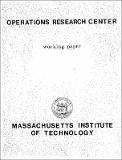| dc.description.abstract | We define a job-shop scheduling problem with three dynamic decisions: assigning duedates to exogenously arriving jobs, releasing jobs from a backlog to the shop floor, and sequencing jobs at each workstation in the shop. The objective is to minimize both the work-in-process (WIP) inventory on the shop floor and the due-date lead time (due-date minus arrival date) of jobs, subject to an upper bound constraint on the proportion of tardy jobs. A general two-step approach to this problem is proposed: (1) release and sequence jobs in order to minimize the WIP inventory subject to completing jobs at a specified rate, and (2) given the policies in (1), set due-dates that will attempt to minimize the due-date lead time, subject to the job tardiness constraint. A simulation study shows that this approach easily outperforms other combinations of traditional due-date setting,job release, and priority sequencing policies. As a result of the study, three scheduling principles are proposed that can significantly improve the performance of a job shop. In particular, better due-date performance can be achieved by ignoring due-dates on the shop floor. | en_US |

